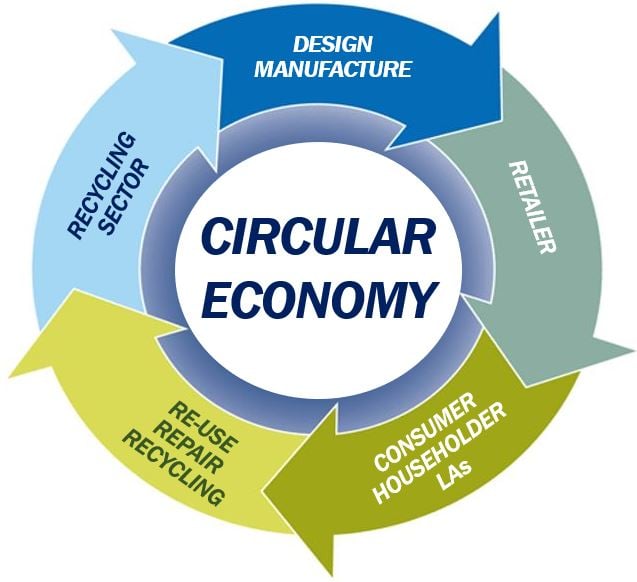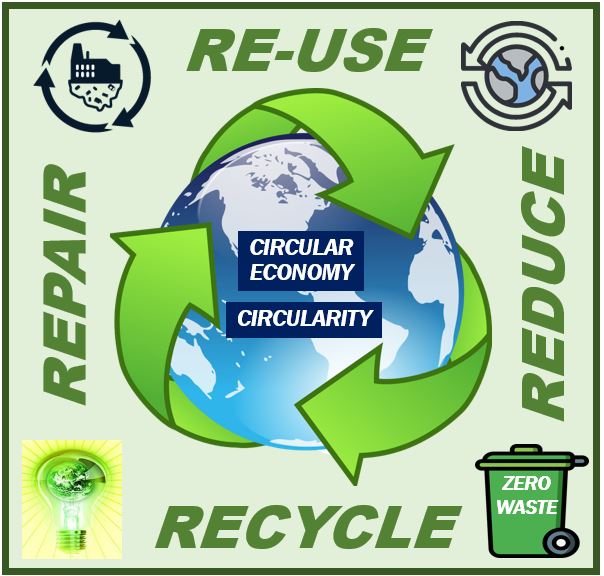What is a circular economy? Definition and examples
A Circular Economy is one whose ultimate aim is to do away with waste and the continual consumption of Earth’s resources. We often use the term Circularity with the same meaning. We can use circularity for the economy or individual companies, as in: “XXX Corporation has achieved circularity across its entire operations.”
Circular economies create a closed-loop system by employing sharing, repair, re-use, remanufacturing, refurbishment, and recycling. They bring down their resource inputs and waste creation to a minimum, as well as carbon emissions and pollution.
Embracing circularity, businesses not only contribute to environmental sustainability but also signal to increasingly eco-conscious consumers their commitment to responsible stewardship of resources.

Circular economy – use things for longer
The aim of a circular economy is to use infrastructure items and equipment for significantly longer than usual, i.e., improving these resources’ productivity. Any type of waste should not be thrown out. Rather it should become another process’ food.
It contrasts with the linear economy, which has traditionally used the production model of “take, make, and dispose.”
Wikipedia.org has the following definition of the term:
“A circular economy (often referred to simply as ‘circularity’ is an economic system aimed at eliminating waste and the continual use of resources.”
“Circular systems employ reuse, sharing, repair, refurbishment, remanufacturing and recycling to create a closed-loop system, minimizing the use of resource inputs and the creation of waste, pollution and carbon emissions.”
Our perspective must change
For the circular economy to ever exist properly, there needs to be a dramatic change in people’s and companies’ perspectives regarding value creation, employment, the scarcity of resources, and environmental impact.
Our planet is currently facing some serious problems caused by economic activity and household consumption. The World Bank says that the OECD nations generate 572 tons of garbage annually. This represents 44% of the world’s total. However, the OECD’s population makes up less than 20% of the world’s population.
Regarding global waste generation, Iberdrola.com says the following:
“Although these figures are huge (OECD waste generation), they pale in comparison to the planetary scale: throughout the world, more than 3.5 million tons of waste are accounted for per day and over the year, this amount rises to about 1.3 billion tons.”

Business leaders embracing the circular economy
The idea of the circular economy started off as an academic theory. It took many years to enter the business world – but now it has. Our natural resources are not limitless; one day they will run out. In fact, as far as some vital resources are concerned, we are rapidly reaching the point of exhaustion.
The price of many natural resources as well as essential materials are skyrocketing. The world’s advanced economies have become aware of this and are currently closely examining alternative economic models – especially the circular economy.
-
It makes business sense
There is a lot in the circular economy model that is attractive for businesses. For example, if you can use equipment for longer, productivity increases and your costs will be lower. This benefit helps boost the bottom line, i.e., profits.
The following quote comes from an article in The Conversation:
“Extending the life of products and materials prevents the over-generation of waste and recovers the full value of products.”
“This would create new business opportunities and revenue streams, while minimizing the environmental impact of mining, resource extraction, refining and manufacture.”
-
It makes economic sense
Protecting jobs – reducing unemployment – is a top priority for all govenments and most central banks across the world. Economists say that any approach towards a circular economy is fantastic for job creation.
In one of our previous articles, Veronica Cruz wrote:
“A shift towards a circular economy could generate 100,00 new jobs and $1 trillion annually for the global economy by 2025, according to a new report released by the World Economic Forum and the Ellen MacArthur foundation at the Annual Meeting 2014 in Davos-Klosters, Switzerland.”
All companies need to do is focus on encouraging the creation of circular supply chains to boost the rate of recycling, re-use, and remanufacture.
Moreover, by adopting circular economy principles, companies can experience reduced material costs and foster innovation through the development of new sustainable products and services.
Video – What is a Circular Economy?
This video presentation, from our sister channel on YouTube – Marketing Business Network, explains what the meaning of ‘Circular Economy’ is using simple and easy-to-understand language and examples.

